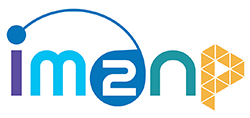Séminaire Younes Abid- 24 avril 2019 - Hybrid organic inorganic perovskites and their derivatives: promising materials for optoelectronic and photovoltaic devices
Invitation : Khalifa Aguir (Département DETECT, Equipe MCI).
Diffusion : IM2NP
SEMINAIRE Mercredi 24 avril 2019 à 11h00
Salle de réunion MCI, service 152
Younes Abid
Laboratoire de Physique Appliquée- Université de Sfax – Bp1171 - 3000 Sfax
HYBRID ORGANIC INORGANIC PEROVSKITES AND THEIR DERIVATIVES: PROMISING MATERIALS FOR OPTOELECTRONIC AND PHOTOVOLTAIC DEVICES
Organic perovskites CH3NH3MX3 and their derivatives with the formula (R-NH3)nMXm where R is an organic group, M is a metal and X an halogen, form a large family of self-assembled and nano structured materials. Their structures are built up from MX6 octahedra, sharing, corners, edges, or faces to form two dimensional slabs (2D), one dimensional chains (1D) or zero dimensional clusters (0D) separated by the organic cations. From electronic and optoelectronic point of view, these Low dimensional structures 2D,1D and 0D may be regarded as quantum well, quantum wire and quantum dot systems respectively, in which slabs, chains and clusters act as semiconductors and the organic molecules act as barriers. In the last decades, these materials have gained great interest due to their interesting properties and potential technological applications including light emitting diodes (LED) and field-effect transistors (FET) . More recently the organic inorganic lead halides CH3NH3PbX3, have also been used as absorber medium in photovoltaic solar cells giving rise to an important improvement efficiency, from 12 % in 2012 to a 22.1% in 2016. In all previous studies lead (Pb) is the most widely used metal and leads to the best optical performance. Because its toxicity, recent researches have been oriented towards the use of other metals such as Sn and Bi. In this context we undertake in our laboratory several systematic studies in search of competitive properties with less toxic metals, we have also incorporated
In addition to the resulting technological prospects, such a hybrid structure provides an ideal system for studying the excitonic recombination involving a Förster resonance energy transfer (FRET) [1] and charge transfer in which a luminescent donor molecule transfer energy via nonradiative dipole-dipole interaction to a luminescent acceptor molecule. This process is efficient when the two molecules are placed in close proximity interaction distance, and have a large spectral overlap of donor emission and acceptor absorption spectra [2-5].
We have obtained numerous quantum well, quantum dot and quantum wire crystals. optical properties were investigated by photoluminescence and absorption measurements. In this lecture we present the most interesting materials which exhibit an intense luminescence related to a strongly bound exciton. We will also focus, on the origin of white light emission in this family of materials.
- Amira Samet, smail triki, Younes Abid. Journal of Physical Chemistry 02- 2019
- Hamdy. Barkeoui , Younes. Abid, Journal of Physical Chemistry 2018 DOI: 10.1021/acs.jpc7b12.175
- T.hameur Dammak , Younes Abid Optical Materials . 61 02/2017
- Yangui Aymen, Sébastien Pillet, Adnen Mlayah, Alain Lusson, Guillaume Bouchez, Smail Triki, Younes Abid, Kamel Boukheddaden: The Journal of Chemical Physics 12/2015; 143(22)
- Aymen Yangui, Mouhamadou Sy, Liang Li, Younes Abid, Panče Naumov, Kamel Boukheddaden: Scientific Reports 12/2015; 5(16634).

